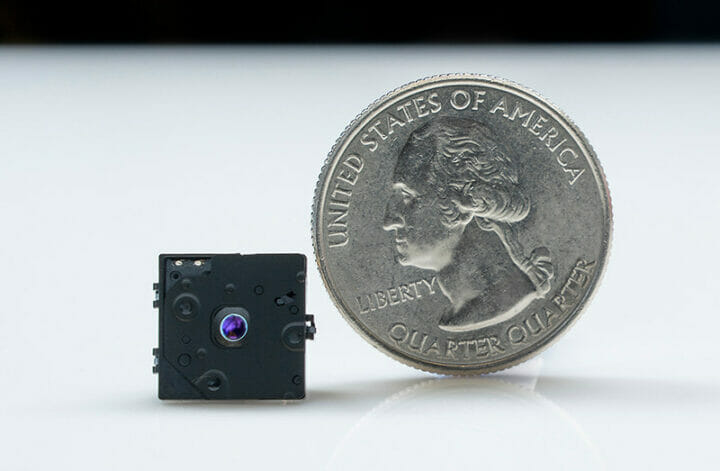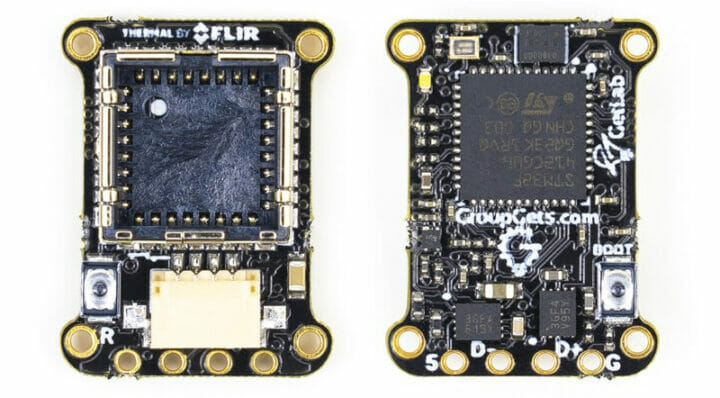Thermal cameras based on FLIR Lepton modules are pretty cool, but also quite expensive. Teledyne FLIR Lepton FS offers a much more cost-effective solution with the non-radiometric 160 x 120 resolution micro thermal camera module going for $99, or about 50% less than other FLIR thermal camera modules.
The lower cost was achieved with some tradeoffs, notably a reduction of thermal sensitivity and scene dynamic range, as well as up to 3% inoperable pixels. But Ron Justin, GroupGets founder, told CNX Software that the lower specs are more than worth it for users only needing an imager, as opposed to a radiometric sensor.
 Lepton FS module specifications:
Lepton FS module specifications:
- Sensor technology – Uncooled VOx microbolometer
- Spectral range – Longwave infrared, 8 μm to 14 μm
- Array format – 160 x 120, progressive scan
- Pixel size – 12 μm
- Effective frame rate 8.7 Hz (commercial application exportable)
- Thermal sensitivity – <75mK NEDT (noise equivalent differential temperature))
- Operability
- Number of non-defective pixels – >97%
- Automatic temperature compensation
- Output image independent of camera temperature.
- Non-uniformity corrections – Integral Shutter
- Scene dynamic range
- High Gain Mode: -10 to 140 degrees C typical
- Low Gain Mode: -10 to 350 degrees C typical
- Image optimization – Factory configured and fully automated
- FOV – horizontal: 57°; diagonal: 71°
- Lens Type- f/1.1
- Output format – User-selectable 14-bit, 8-bit (AGC applied), or 24-bit RGB (AGC and colorization applied)
- Integral solar protection
- Host interfaces – SPI for video data, CCI (I2C-like) for control
- Input supply voltage – 2.8 V, 1.2 V, 2.5 V to 3.1 VIO
- Power consumption
- 150 mW operating
- 650 mW during shutter event
- 5 mW in standby mode
- Dimensions – 11.50 x 12.70 x 6.84 mm (without socket)
- Weight – 0.91 grams
- Temperature Range – Operating: -10C to +65C; storage: -40 C to +80 C
- Shock – 1500 G @ 0.4 ms
While the Lepton FS is not suitable for radiometric applications, the module can still be used for heat, security, and comfort monitoring applications in the fields of home and building automation, heat and occupancy sensing, or security and location monitoring.

Since Lepton FS is mechanically and electrically compatible with FLIR Lepton 2 to 3.5 thermal camera modules, it can fit into existing boards with the appropriate socket such as PureThermal Mini Pro JST-SR, the ESP32-based tCam-Mini IR thermal camera board, OpenMV PureThermal, and others.
Teledyne FLIR Lepton FS is currently available on GroupGets for $99 plus shipping in limited quantities (100 units). You can also get some of the development boards listed above as part of the group buying campaign, including a 10% discount for specific models.

Jean-Luc started CNX Software in 2010 as a part-time endeavor, before quitting his job as a software engineering manager, and starting to write daily news, and reviews full time later in 2011.
Support CNX Software! Donate via cryptocurrencies, become a Patron on Patreon, or purchase goods on Amazon or Aliexpress




